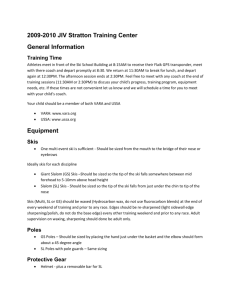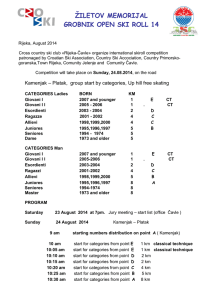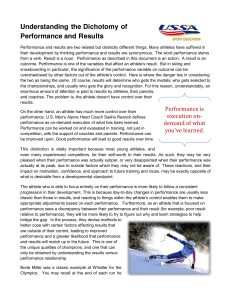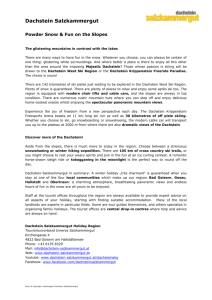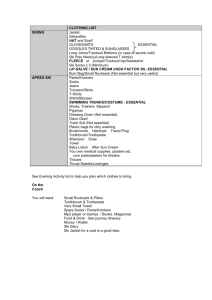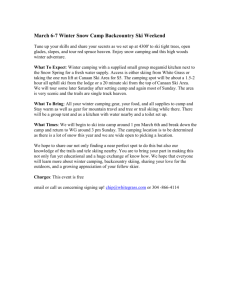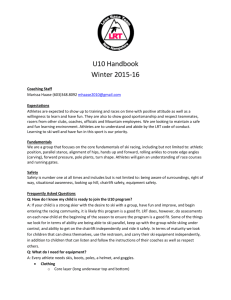Team Handbook - Sports Websites
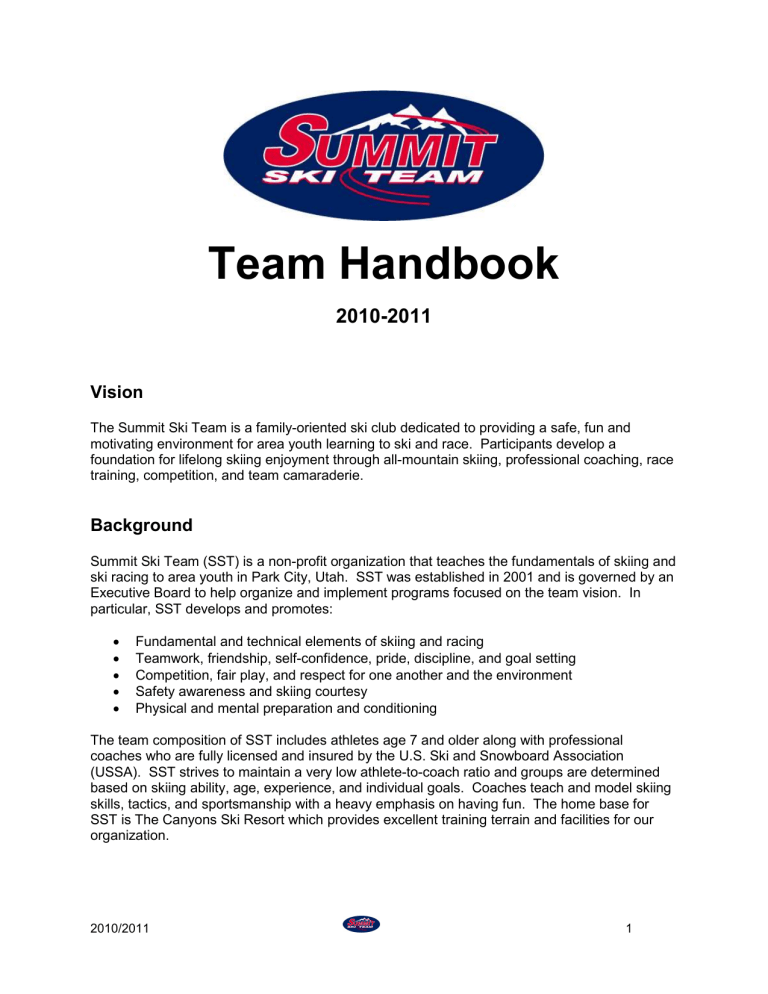
Team Handbook
2010-2011
Vision
The Summit Ski Team is a family-oriented ski club dedicated to providing a safe, fun and motivating environment for area youth learning to ski and race. Participants develop a foundation for lifelong skiing enjoyment through all-mountain skiing, professional coaching, race training, competition, and team camaraderie.
Background
Summit Ski Team (SST) is a non-profit organization that teaches the fundamentals of skiing and ski racing to area youth in Park City, Utah. SST was established in 2001 and is governed by an
Executive Board to help organize and implement programs focused on the team vision. In particular, SST develops and promotes:
Fundamental and technical elements of skiing and racing
Teamwork, friendship, self-confidence, pride, discipline, and goal setting
Competition, fair play, and respect for one another and the environment
Safety awareness and skiing courtesy
Physical and mental preparation and conditioning
The team composition of SST includes athletes age 7 and older along with professional coaches who are fully licensed and insured by the U.S. Ski and Snowboard Association
(USSA). SST strives to maintain a very low athlete-to-coach ratio and groups are determined based on skiing ability, age, experience, and individual goals. Coaches teach and model skiing skills, tactics, and sportsmanship with a heavy emphasis on having fun. The home base for
SST is The Canyons Ski Resort which provides excellent training terrain and facilities for our organization.
2010/2011 1
Programs
SST programs are designed around age divisions within the Intermountain Division of USSA
(IMD) and athletes compete against their peers in local and regional races. There are two primary race series that SST participates in
– Youth Ski League and South Series. SST programs encompass an increasing scale in terms of training and competing in order to meet athletes’ needs as they grow older and evolve with skiing and racing. Participants can choose a program based on their proficiency as well as their individual desires.
Intro
The Intro Program is for ages 7-12. These skiers will ski primarily Saturdays with the option of attending occasional “race prep” sessions that occur prior to races. Skiers will build a base of solid skiing skills and basic fundamentals through directed free skiing, all-mountain skiing, and introductory gate training. Emphasis will be on improving free-skiing skills, basic race fundamentals, skiing etiquette and safety. Intro skiers are encouraged to race in Youth Ski
League races, of which there are typically 4 each season. NOTE : New Intro Program skiers must be able to load chairlifts independently, confidently ski blue runs, and have an eagerness to tackle black runs and other challenging conditions.
Ages 7-12, 1 day per week, approximately 15 training days and 1-5 racing days.
Intro+
The Intro+ Program is designed for the 7-12 year old who would like an enhanced program that includes all the training of the Intro Program plus one evening session per week – Wednesdays at the Utah Olympic Park (UOP). In addition to what is offered with the Intro Program, Intro+ athletes will further emphasize the development of basic skiing fundamentals such as: stance, balance, skiing more challenging terrain, and gate training. Intro+ Program members will compete in YSL races and have the option to race in 1 or 2 designated South Series races.
Ages 7-12, 2 days per week, approximately 25 training days and 5-8 racing days.
Comp
The Comp program is for J4/J5 skiers (ages 9-12) who are a bit more serious about training as well as racing. These athletes will train 3 times per week and compete in several races per season. Training will be Saturdays, most Sundays, and Wednesday evenings at PCMR.
Racing will focus on transitioning from YSL races to the slightly longer and more challenging
South Series races. This program will build on the fundamentals taught in the Intro programs by improving techniques in free-skiing and race training, race tactics, and skiing skills in and out of the gates.
Ages 9-12, 3 days per week, approximately 33 training days and 8-12 racing days.
Comp+
The Comp+ Program is for motivated J5 and older (ages 10+) skiers with an increased interest in developing their skiing and racing ability through additional training. Comp+ athletes will train
2010/2011 2
4 times per week: Saturdays, most Sundays, Wednesday evenings at PCMR, and Fridays at the UOP. These skiers will compete primarily in South Series races while J3+ skiers will also have the option to race at selected J3 qualifier races and/or other local IMD races. Besides racing, the Comp+ program continues to focus on all-mountain free-skiing, technical drills, gate training (including speed elements of Super G), and goal setting.
Ages 10+, 4 days per week, approximately 45 training days and 8-12 racing days.
Selection of Coaching Groups
In order to determine on-snow coaching groups, coaches will assess athletes during the first training sessions based on the following guidelines (adjustments may occur at times to ensure the skier is receiving appropriate training and development):
Technical skiing ability
Age
Race ability and experience
Goals
Athlete Evaluations
Written athlete evaluations will be performed once or twice during the season. We try to do a sh ort evaluation early in the season that focuses on an athlete’s primary strengths and weaknesses. This forms the basis of what they should work on and also provides a reference point for the later evaluation to be compared to. Evaluations are completed b y the athlete’s primary coach.
2010/2011 3
Requirements and Responsibilities
Summit Ski Team is a ski racing program at heart, and consequently, there are minimum standards that participants must meet. In addition, SST is a non-profit, mostly volunteer run organization and requires the help of everyone involved to run smoothly.
Athlete Requirements
Minimum age of 7 (6 with head coach approval).
Able to ski confidently on all intermediate and advanced terrain and in all conditions.
Able to load/unload chairlifts without assistance.
Able to manage their own equipment without assistance.
Athletes are required to wear USSA approved helmets (hard ear covering) and must have suitable equipment and clothing for all training/racing.
All participants must have a current USSA membership.
Athlete Responsibilities
1. Follow the rules as set forth by the Summit Ski Team, the ski area(s), and USSA, both at
The Canyons and while traveling. This includes staying in bounds, maintaining control and reasonable speed, no jumping off ski lifts, or unauthorized lift line cutting.
Infractions may result in loss of season pass.
2. Understand and follow the Skier/Snowboarder Responsibility Code.
3. Inverted and rotational/360 degree jumps are forbidden.
4. Conduct oneself with the highest level of integrity. Keep frustrations and temper in check. Profane language will not be tolerated. Show respect and support to teammates and staff and to each other’s property.
5. Rely upon and obey the judgment and direction of the coaches.
6. Report any injury to an SST Coach or Canyons employee immediately.
7. Be on time for scheduled training and races.
8. Help keep training courses clear for other athletes, conduct pre-race course inspections, slip training courses as requested, help setup and take down training courses as requested.
9. Give coaches appropriate advance warning of inability to attend training.
Membership on SST is conditional upon abiding by the rules and principles of the team. In the event an athlete violates any Summit Ski Team rule, the coaches will handle the offense in the following manner:
1 St Offense – coach will discuss with athlete.
2 Nd Offense – coach will discuss with athlete and notify parents.
3 Rd Offense – coach will notify parents in writing and athlete will be suspended for one week and may miss next race.
2010/2011 4
Parent/Guardian Responsibilities
Provide transportation to and from training sessions and race events. Parents always need to make positive contact with coaches for late drop-off or early pick-up. Athletes will not be permitted to ski to or ski away from the body of the team unescorted by an adult (think school drop-off/pick-up). Note: Coaches cannot transport racers.
Accept and uphold coaches’ and executive board decisions, which are made with the intention of providing the most successful environment for the athletes.
Contribute a minimum of 10 hours of volunteer time per family, per season.
Opportunities to fulfill the volunteer obligation usually occur in the fall, especially in conjunction with Jans Winter Welcome.
Contribute one adult per family to assist with official races that SST hosts. This obligation is in addition to the general 10-hour volunteer commitment. For this year, SST will be hosting the following races: o South Series race, January 29-30, 2011 (slalom both days)
2010/2011 5
Equipment
Skis
Skis for junior racers come in four general categories: Kombi, Slalom (SL), Giant Slalom (GS), and Super-G (SG). Slalom skis have more side cut than giant slalom skis (short, quick turns versus longer turns) while Kombi skis try to find a middle ground for beginning racers. All ski companies make good products and it’s mostly personal preference as to which brand to use.
YSL skiers (Intro, Intro+) will generally need one pair of training/racing skis and they should be either Slalom or Kombi. You should also consider having an extra pair of skis for early season
(rock skis) or for when conditions could otherwise be hard on bases.
South Series skiers (Comp and Comp+) will need both Slalom and GS skis and J4 and older skiers (11+) should consider Super-G skis with coach guidance. Most skiers this age will also have a pair of general purpose all-mountain skis for non-technical training, early season, powder days, etc.
Ski Sizing (wearing ski boots): In general, s ki length should be between the chin and the top of the forehead with SL skis more at chin level and GS skis more at forehead level. Kombi skis fall in between SL and GS (nose height plus or minus 2 inches) and Super-G skis are a couple inches longer than GS. S kier weight and skiing style as well as ski stiffness are all important factors in sizing and buying skis. Consult with a coach before buying if you have questions.
Bindings: Youth ski bindings (DIN up to 4.5) are probably OK for kids up to about 60 pounds.
Heavier or more aggressive kids should be in something at least DIN 7 or 10. Also, as kids really learn to carve, the benefit of some extra rise off the ski is significant (riser plate or binding).
Boots
Good quality, properly fitted boots are essential. Good boots = happy feet = happy kids. Cold or uncomfortable boots = unhappy kids. There are many good brands although Nordica, Lange and Rossignol are well-proven junior boots. Boots should be 4 buckle – do not use rear-entry boots.
A softer flexing boot will be more effective than a stiffer boot due to strength limitations and skill level. To determine if a boot is soft enough for your child you should be able to clearly see the boot flex forward in unison with the lower leg. If the upper boot cuff does not move or moves very little, the boot is too stiff and will hinder your child in their skill progression.
Boot Sizing: Boots should fit properly, tight but not uncomfortable. Remember the boots might feel too tight at first but will break in within a few days on the slopes. Buying boots oversized is counter productive to both performance and fit. A good way to size boots is to shell-fit: remove the liner, wear normal ski socks, stand up straight and put the toes to the front of the boot.
There should be about two fingers of room (3/4 to 1 inch) between the heel and the back of the boot. Also, with the liner out you can easily see how the foot fits into the liner itself.
Helmets
USSA approved ski helmets are mandatory for all training and racing , no exceptions . It is now required under USSA rules that all racers must have a hard sided helmet (no soft ear flaps). If you show up at the start of a race without a proper helmet you won’t be allow to race. Proper sizing, fit and securing of helmets is absolutely essential to skier safety.
2010/2011 6
Other Equipment
Everyone knows how extreme the weather can get at a ski area in winter and it can change drastically during the course of a day. Suitable clothing is very important. It doesn’t have to be expensive, state-of-the-art or flashy, but it does have to fit comfortably, be waterproof, and not hinder aggressive skiing. Also, make sure you put your name on any equipment that might get lost, left behind or inadvertently switched with someone else’s (skis, poles, helmet, jacket, …)
Snow Pant/Zip Offs
– Pretty much any of your basic ski pants work fine as long as they’re waterproof and fit over boots. If your racer will be using a speed suit, the pants need to have a full-length side zipper.
Goggles – A good pair of well-fitting goggles is very important. Ski racing inherently focuses on speed and good visibility will make a big difference in skier confidence. Athletes who train under lights (Intro+, Comp, Comp+) will want a pair of goggles suitable for night skiing. Use a clear lens or one that is designed to use under artificial light .
Speed suits – A lot of first-time parents and kids are surprised when they get to the first race and see the majority of kids decked out speed suits, even some of the very youngest. Speed suits are optional and the advantage gained is sometimes more psychological than real. Comp and Comp+ kids will definitely want a speed suit and are encouraged to wear it when training gates and racing (train like you race, race like you train). There are many speed suits out there but the affordable, used ones tend to get snatched up quickly, especially at ski swaps.
Protective Gear – Shin guards, pole guards, and chin (face) guards are highly recommended for the Comp and Comp+ skiers when training slalom. Note: we are not trying to kill the gates just protecting our young racers. The Intro and Intro+ skier or YSL skier will not need protective gear unless their coach recommends it.
No Backpacks – Please don’t have your child wear a backpack on training days. They have a nasty habit of getting tangled up with chairlifts and are easily lost.
EQUIPMENT
Kombi Skis
SL Race Skis
GS Race Skis
INTRO
X
Optional
Optional
INTRO+
X
Optional
Optional
COMP
X
X
COMP+
X
X
Super-G Skis
4-buckle Boots
Poles
Helmet (no soft ear flaps)
Goggles
Goggles for night training
Warm Layered Clothing
Race Suit
Shin Guards
Chin Guard for helmet
Pole Guards
X
X
X
X
X
Optional
X
X
X
X
X
X
Optional
Optional
Optional
X
X
X
X
X
X
X
X
J4+
J4+
Optional
X
X
X
X
X
X
X
X
J4+
J4+
2010/2011 7
Schedule
The SST season runs from early December through late March, lasting about 16 weeks. The early part of the season focuses on free skiing techniques, drills, and fundamentals. Gate training and event specific training generally starts after the first of the year and all of the competitions are stacked toward the second half of the season.
Training Schedule
The training schedule consists of the following (everyone trains on Saturday; other sessions are optional depending upon program):
Saturdays (Intro, Intro+, Comp, Comp+): 9:00am – 3:30pm, (Canyons)
Sundays (Comp/Comp+): morning only, usually 9:00am – 12:00pm, (Canyons or PCMR)
Wednesday Evening (Intro+): 5:00pm – 7:00pm, (UOP, under lights)
Wednesday Evening (Comp/Comp+): 4:15pm – 6:30pm, (PCMR, under lights)
Friday Evening (Comp+): 5:00pm – 7:00pm, (UOP, under lights)
In addition, special camps are offered during holiday periods with a concentration on allmountain, all-condition skiing.
Saturdays @ The Canyons:
Drop off: 8:45am – Canyons Forum area
Pick up: 3:30pm – Canyons Forum area
8:45am
9:00am
Athletes and Coaches meet at the top of the cabriolet
Groups disburse with Coach
11:30-12:30pm Lunch at Sun Lodge (time is approximate) (Into/Intro+)
12:30-1:15pm Lunch at Sun Lodge (Comp/Comp+)
3:30pm Athletes released at the top of the cabriolet
In early season (December), mornings will focus on fundamental skiing techniques and drills.
During race season (January-March), mornings will focus on gate training (conditions depending). Throughout the season, afternoons will be directed free skiing (all mountain/all conditions).
Wednesdays, Fridays @ UOP:
Drop off: 5:00pm
– UOP Day Lodge (obtain wrist band each session)
Pick up: 7:00pm – UOP Day Lodge
Training at the UOP will consist of a variety of disciplines. The hill is fairly short and accessed by a surface lift. Gate training will probably be slalom only due to the hill length. Other training possibilities include the small nordic jumps, moguls, and terrain park features.
Wednesdays, Sundays @ Park City:
Drop off: 4:15pm – Eagle Lift (lower parking lot)
Pick up: 6:30pm – Eagle Lift
Training will be off the Eagle chairlift (when open) and will consist mostly of gate training.
Athletes are expected to help with course set/removal and must always inspect the course beforehand.
2010/2011 8
Race Schedule
The competition schedule for SST consists of events primarily in the Youth Ski League (YSL) and the South Series (SS). Athletes will generally do one race series or the other, although some racers may do both as a part of transitioning.
The schedule for all USSA-IMD races is on the IMD website ( http://www.ussa-imd.org
)
YSL (J6, J5, J4 only, age 7-12)
Jan. 22 (Sat):
Feb. 19 (Sat):
Park City
Snowbasin
Mar. 5 (Sat): Snowbird
Mar. 11-14 (Fri-Sat-Sun): Snowbasin
South Series (J5+ for most races, age 9+)
Jan. 15-16 (Sat-Sun):
Jan. 29-30 (Sat-Sun):
Feb. 19-20 (Sat-Sun):
Mar. 4-6 (Fri-Sun):
Snowbasin, GS+GS
Canyons, SL+SL (SST volunteers required)
Park City, SL+GS
Snowbasin, SG+SG+SG (J4+)
Mar. 19-20 (Sat-Sun):
Mar. 25-27 (Fri-Sun):
Brighton, GS+SL
Snowbird, IMD Championships, SL+GS+SG
J3 Qualifiers & Open Series (J3+ only, age 13+)
Dec. 16-19 (Thu-Sun):
Jan. 29-30 (Sat-Sun):
Apr. 1-4 (Fri-Mon):
Park City, Open Series (Eric Hayes), SL+SL+GS+GS
Park City, J3 Qualifier, GS+SL
Snowbird, Open Series, SL+SL+GS+GS
SL = Slalom, GS = Giant Slalom, SG = Super-G
Race Results
Results for all USSA-IMD races are posted on the IMD website, usually within a day after the race.
IMD race results link: http://www.ussa-imd.org
2010/2011 9
Athlete Progression
Within the Intermountain Division of USSA, there are several different race series that form a progression of racing difficulty. These are YSL, South Series, J3, and Open. There are both hard and fast eligibility rules as well as more general guiding principles for how athletes progress from one level to another. Athletes who experience success at a particular level are expected to transition to the next level. Racing at a lower level for the purpose of individual glory is considered bad form. While athlete proficiency is the overriding factor determining what level an athlete should compete at, there are other factors that come into play and it’s best to consult with a coach to determine which level is best for a given athlete.
YSL to South Series Transition
Athletes of appropriate age who are proficient and/or successful at the YSL level should begin competing in South Series events. At the point when they become proficient at the higher level, they are expected to race only at that level.
Rules for YSL eligibility – Athletes will not be eligible for YSL races if any of the following are true:
Athlete is J3 or older (age 13+). YSL is only for J6, J5 and J4 racers (age 6-12).
Athlete has placed in the top 5 in any South Series race.
Athlete has 8 or more race starts (days) in a season, YSL + South Series combined.
(This is an SST rule.)
No athlete may race in both the YSL Finals and the IMD Championships in a single season. The YSL Finals usually come before IMD Champs so athletes need be aware of their qualifying status for IMD Champs before they choose which of these races to enter.
Rules for South Series eligibility – Athletes will not be eligible for South Series races if any of the following are true:
Athlete is younger than age 8. J6 athletes rarely compete at the South Series and must have approval from the Head Coach in order to compete.
Athlete is J3 or older and has lower than 200 USSA points.
South Series to J3 Transition
The transition from South Series to J3 is usually more abrupt than from YSL to South Series. J4 and younger athletes are not allowed to race in any J3 or older race series. Starting at the J3 level (age 13), athletes begin to use the USSA national point system which provides a measure of athletes’ relative ability. This point system is a “lower-is-better” scale where athletes strive to reduce their points by doing well against the relative strength of the field. Athletes with less than
200 points are not eligible to race at the South Series.
The USSA website has a great deal of material dedicated to athlete progression and development. See http://www.ussa.org/magnoliaPublic/ussa/en/sports/alpine.html
.
2010/2011 10
Glossary
USSA – United States Ski & Snowboard Association ( http://www.ussa.org
). USSA is the governing body of nearly all snowsports in the United States, including alpine, nordic, jumping, snowboard, and freestyle (SST competes in alpine). As such, it is a very large organization and exerts tremendous influence over competitive skiing. The corporate headquarters of USSA are in Park City. USSA follows a tiered approach to cultivating ski racers that begins with junior athletes competing in YSL races and culminates in the United States Ski Team. Each member of SST is required to be a member of USSA.
IMD – Intermountain Division of USSA ( http://www.ussa-imd.org
). IMD is the regional division of
USSA in which SST competes. The region encompasses Utah, southern Idaho, and western
Wyoming. The IMD website is the place to go for race results.
J6, J5, J4, … – The “J” classifications are age groups designated by USSA and junior athletes always compete against others in their age classification. Groups are based on an athlete’s age as of December 31 st of the ski year, as follows:
J6
– age 6-8
J5 – age 9-10
J4
– age 11-12
J3 – age 13-14
J2
– age 15-16
YSL –Youth Ski League. YSL comprises the youngest athlete grouping within USSA and is where SST has traditionally been focused. The main purpose of YSL is to offer entry-level ski racing for athletes age 6-12 (J6-J4), and the stiffest competition is usually among the J5 group.
There are several YSL races held each year and they are one-day events except for the YSL
Championships which is a 2-day event. YSL courses are usually short and spectator friendly.
South Series (SS) – The South Series is the next level of ski racing beyond YSL. South Series events are open to junior racers age 9+ (J5-J1), and are most competitive at the J4 level. South
Series races are typically 2-day events with longer, steeper, and more technical courses than racers experience at YSL. J3 series is the next step above SS.
YWSA – Youth WinterSports Alliance ( http://www.ywsa.org
). YWSA is an umbrella organization for several winter-oriented clubs in Park City, including SST. The main purpose of this organization is to promote and fundraise for youth sports in general and YWSA member clubs in particular. YWSA sponsors several events throughout the year, but by far the largest is the
JANS Winter Welcome, held in October each year. Member clubs provide the volunteers and legwork to help organize and host these events, and in return receive funding from YWSA.
Summit Ski Team has been a YWSA member for several years and has benefited significantly from this relationship.
JWW – JANS Winter Welcome (JWW) is the premier fundraising event for YWSA. Held each
October, it is a formal, black-tie affair that features Olympic athletes and dignitaries, top local cuisine, and a variety of silent and live auctions. This event is put on by YWSA and involves a huge volunteer effort that each member club is required to commit to. SST takes this commitment very seriously and has traditionally been recognized as one of the hardest-working organizations within YWSA.
2010/2011 11
Contact Information
Summit Ski Team
P.O. Box 981594
Park City, UT 84098
Board Members
Name Role
Email: info@summitskiteam.org director@summitskiteam.org
Website: www.summitskiteam.org
Pete Dunmire President
Bill McGrath Vice President
Cheryl White-Hamrick Treasurer
Sherry Weaver
Sarah Fischer
Stan Kanarowski
Secretary
Coach Rep
Jackets
JWW Julie McCutcheon
Coaches
Name
Matt Brown
Sarah Fischer
Billy Halberstadt
Chris Warren
Kurt Almond
Ali Guinn
Ashley Havlicak
Phone Email
435-962-0334 pete.dunmire@comcast.net
435-659-1417 billmcgrath1@yahoo.com
435-659-0448 cwhitehamrick@aol.com
801-699-0663 sherry@utahbroadband.com
435-640-4554 sarahuh81@yahoo.com
435-513-9022 stan.kanarowski@gmail.com
603-321-6171 juliemnh@gmail.com
Role
Director / Head Coach
Phone Email
435-640-9051 matt.s.brown@comcast.net
Comp/Comp+ Lead Coach 435-640-4554 sarahuh81@yahoo.com
Comp/Comp+ 603-860-4994 bhalbe17@yahoo.com
Comp/Comp+
Intro/Intro+ Lead Coach
941-302-7904 saveferris24@hotmail.com
801-598-5523 kurtalmond@gmail.com
Sarah Morrison
Dave Rosen
Nate Bloomfield
Scott Almond
Brayden Brassey
Taylor Guetschow
David Eckstein
Laurel Vant Hof
Gracie Brown
Intro/Intro+
Intro/Intro+
Intro/Intro+
Intro/Intro+
Intro/Intro+
Intro/Intro+
Intro/Intro+
Intro/Intro+
Assistant Coach
Assistant Coach
Assistant Coach
801-560-6736 ali@jibemedia.com
435-962-4564 ash2690@yahoo.com
435-962-4542 sarah.j.morrison.91@gmail.com
603-219-3960 frap24@hotmail.com
603-491-7718 n.bloomfield@hotmail.com
727-488-2239 theealmond@gmail.com
435-655-5583 brayden1989@msn.com
650-799-3037 taylorgetch@gmail.com
435-640-9653 feckstein@flightline.com
435-659-1904 laxygrl101@hotmail.com
208-720-7883 racer.girl@comcast.net
2010/2011 12


